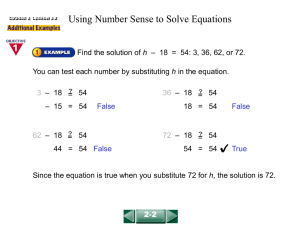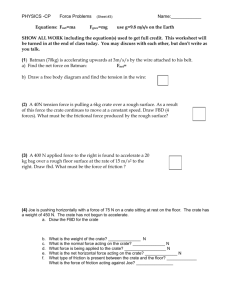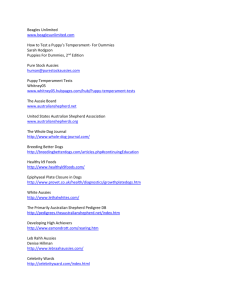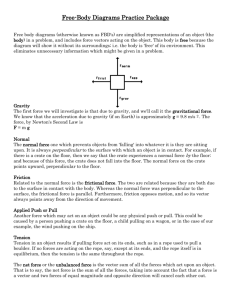Crate Training - Always Hope Animal Rescue
advertisement
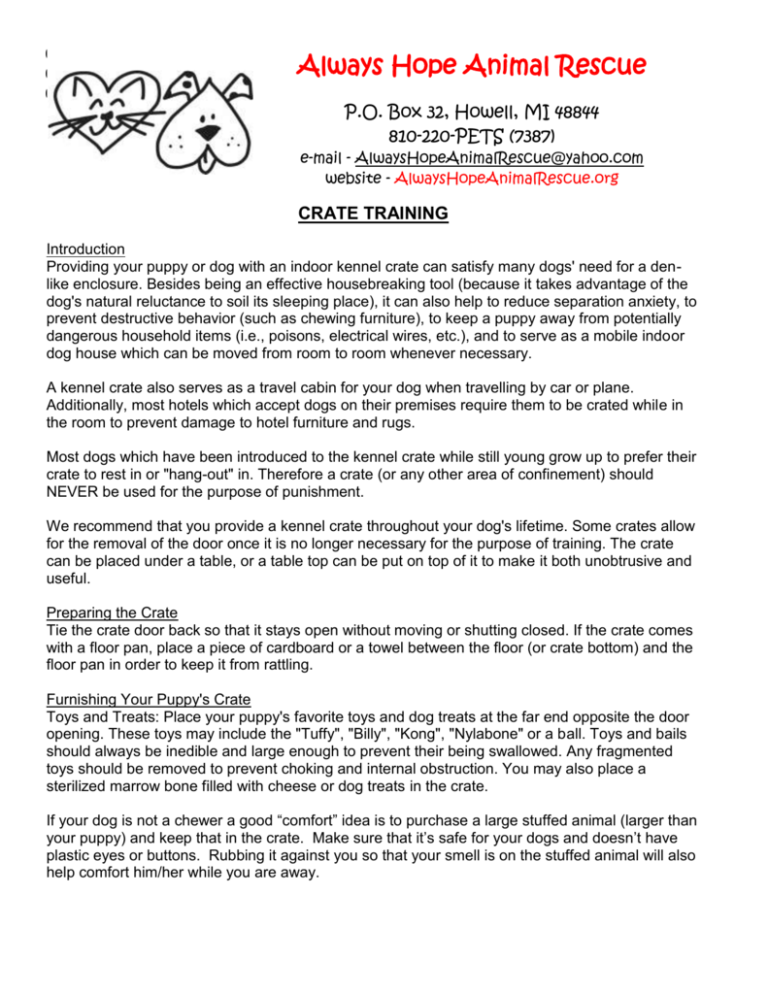
0 0 0 Always Hope Animal Rescue P.O. Box 32, Howell, MI 48844 810-220-PETS (7387) e-mail - AlwaysHopeAnimalRescue@yahoo.com Always Hope Animal Rescue website - AlwaysHopeAnimalRescue.org CRATE TRAINING Introduction Providing your puppy or dog with an indoor kennel crate can satisfy many dogs' need for a denlike enclosure. Besides being an effective housebreaking tool (because it takes advantage of the dog's natural reluctance to soil its sleeping place), it can also help to reduce separation anxiety, to prevent destructive behavior (such as chewing furniture), to keep a puppy away from potentially dangerous household items (i.e., poisons, electrical wires, etc.), and to serve as a mobile indoor dog house which can be moved from room to room whenever necessary. A kennel crate also serves as a travel cabin for your dog when travelling by car or plane. Additionally, most hotels which accept dogs on their premises require them to be crated while in the room to prevent damage to hotel furniture and rugs. Most dogs which have been introduced to the kennel crate while still young grow up to prefer their crate to rest in or "hang-out" in. Therefore a crate (or any other area of confinement) should NEVER be used for the purpose of punishment. We recommend that you provide a kennel crate throughout your dog's lifetime. Some crates allow for the removal of the door once it is no longer necessary for the purpose of training. The crate can be placed under a table, or a table top can be put on top of it to make it both unobtrusive and useful. Preparing the Crate Tie the crate door back so that it stays open without moving or shutting closed. If the crate comes with a floor pan, place a piece of cardboard or a towel between the floor (or crate bottom) and the floor pan in order to keep it from rattling. Furnishing Your Puppy's Crate Toys and Treats: Place your puppy's favorite toys and dog treats at the far end opposite the door opening. These toys may include the "Tuffy", "Billy", "Kong", "Nylabone" or a ball. Toys and bails should always be inedible and large enough to prevent their being swallowed. Any fragmented toys should be removed to prevent choking and internal obstruction. You may also place a sterilized marrow bone filled with cheese or dog treats in the crate. If your dog is not a chewer a good “comfort” idea is to purchase a large stuffed animal (larger than your puppy) and keep that in the crate. Make sure that it’s safe for your dogs and doesn’t have plastic eyes or buttons. Rubbing it against you so that your smell is on the stuffed animal will also help comfort him/her while you are away. Water: A small hamster-type water dispenser with ice water should be attached to the crate if your puppy is to be confined for more than two hours in the crate during the day. Don’t keep water in the crate during the night. Bedding: Place a towel or blanket inside the crate to create a soft, comfortable bed for the puppy. If the puppy chews the towel, remove it to prevent the pup from swallowing or choking on the pieces. Although most puppies prefer lying on soft bedding, some may prefer to rest on a hard, flat surface, and may push the towel to one end of the crate to avoid it. If the puppy urinates on the towel, remove bedding until the pup no longer eliminates in the crate. Location of Crate Whenever possible, place the crate near or next to you when you are home. This will encourage the pup to go inside it without his feeling lonely or isolated when you go out. A central room in the apartment (i.e.: living room or kitchen) or a large hallway near the entrance is a good place to crate your puppy. Introducing the Crate to Your Puppy In order that your puppy associate his/her kennel crate with comfort, security and enjoyment, please follow these guidelines: Occasionally throughout the day, drop small pieces of kibble or dog biscuits in the crate. While investigating his new crate, the pup will discover edible treasures, thereby reinforcing his positive associations with the crate. You may also feed him in the crate to create the same effect. If the dog hesitates, it often works to feed him in front of the crate, then right inside the doorway and then, finally, in the back of the crate. In the beginning, praise and pet your pup when he enters. Do not try to push, pull or force the puppy into the crate. At this early stage of introduction only inductive methods are suggested. Overnight exception: You may need to place your pup in his crate and shut the door upon retiring. (In most cases, the crate should be placed next to your bed overnight. If this is not possible, the crate can be placed in the kitchen, bathroom or living room.) You may also play this enjoyable and educational game with your pup or dog: without alerting your puppy, drop a small dog biscuit into the crate. Then call your puppy and say to him, "Where's the biscuit? It's in your room." Using only a friendly, encouraging voice, direct your pup toward his crate. When the puppy discovers the treat, give enthusiastic praise. The biscuit will automatically serve as a primary reward. Your pup should be free to leave its crate at all times during this game. Later on, your puppy's toy or ball can be substituted for the treat. It is advisable first to crate your pup for short periods of time while you are home with him. In fact, crate training is best accomplished while you are in the room with your dog. Getting him used to your absence from the room in which he is crated is a good first step. This prevents an association being made with the crate and your leaving him/her alone. A Note About Crating Puppies Puppies under 4 months of age have little bladder or sphincter control. Puppies under 3 months have even less. Very young puppies under 9 weeks should not be crated, as they need to eliminate very frequently (usually 8-12 times or more daily). Important Reminders Collars: Always remove your puppy or dog's collar before confining in the crate. Even flat buckle collars can occasionally get struck on the bars or wire mesh of a crate. If you must leave a collar on the pup when you crate him (e.g.: for his identification tag), use a safety "break away" collar. Warm Weather: Do not crate a puppy or dog when temperatures reach an uncomfortable level. This is especially true for the short-muzzled (Pugs, Pekes, Bulldogs, etc.) and the Arctic or thickcoated breeds (Malamutes, Huskies, Akitas, Newfoundlands, etc.). Cold water should always be available to puppies, especially during warm weather. [Never leave an unsupervised dog on a terrace, roof or inside a car during warm weather. Also, keep outdoor exercise periods brief until the hot weather subsides.] Be certain that your puppy has fully eliminated shortly before being crated. Be sure that the crate you are using is not too large to discourage your pup from eliminating in it. Rarely does a pup or dog eliminate in the crate if it is properly sized and the dog is an appropriate age to be crated a given amount of time. If your pup/dog continues to eliminate in the crate, the following may be the causes: -The pup is too young to have much control. - The pup has a poor or rich diet, or very large meals. - The pup did not eliminate prior to being confined. -The pup has worms. -The pup has gaseous or loose stools. -The pup drank large amounts of water prior to being crated. -The pup has been forced to eliminate in small confined areas prior to crate training - The pup/dog is suffering from a health condition or illness (i.e., bladder infection, prostate problem, etc.) -The puppy or dog is experiencing severe separation anxiety when left alone. Accidents In The Crate If your puppy messes in his crate while you are out, do not punish him upon your return. Simply wash out the crate using a pet odor neutralizer (such as Nature's Miracle, Nilodor, or Outright). Do not use ammonia-based products, as their odor resembles urine and may draw your dog back to urinate in the same spot again. Crating Duration Guidelines 9-10 Weeks Approx. 30-60 minutes 11-14 Weeks Approx. 1-3 hours 15-16 Weeks Approx. 3-4 hours 17 + Weeks Approx. 4+ (6 hours maximum) *NOTE: Except for overnight, neither puppies nor dogs should be crated for more than 5 hours at a time. (6 hours maximum!) The Crate As Punishment NEVER use the crate as a form of punishment or reprimand for your puppy or dog. This simply causes the dog to fear and resent the crate. If correctly introduced to his crate, your puppy should be happy to go into his crate at any time. You may however use the crate as a brief time-out for your puppy as a way of discouraging nipping or excessive rowdiness. [NOTE: Sufficient daily exercise is important for healthy puppies and dogs. Regular daily walks should be offered as soon as a puppy is fully immunized. Backyard exercise is not enough!] Children And The Crate Do not allow children to play in your dog's crate or to handle your dog while he/she is in the crate. The crate is your dog's private sanctuary. His/her rights to privacy should always be respected. Barking In The Crate In most cases a pup who cries incessantly in his crate has either been crated too soon (without taking the proper steps as outlined above) or is suffering from separation anxiety and is anxious about being left alone. Some pups may simply under exercised. Others may not have enough attention paid them. Some breeds of dog may be particularly vocal (e.g., Miniature Pinchers, Mini Schnauzers, and other frisky terrier types). These dogs may need the "Alternate Method of Confining Your Dog", along with increasing the amount of exercise and play your dog receives daily. When Not To Use A Crate Do not crate your puppy or dog if: -S/he is too young to have sufficient bladder or sphincter control. - S/he has diarrhea. Diarrhea can be caused by: worms, illness, intestinal upsets such as colitis, too much and/or the wrong kinds of food, quick changes in the dogs diet, or stress, fear or anxiety. - S/he is vomiting. - You must leave him/her crated for more than the Crating Duration Guidelines suggest. -S/he has not eliminated shortly before being placed inside the crate. -The temperature is excessively high. -S/he has not had sufficient exercise, companionship and socialization. The cost of not using a crate: -your shoes -books -table legs; -chairs and sofas; -throw rugs and carpet, and -electric, telephone and computer wires. The real cost, however, is your dog's safety and your peace of mind. Alternative Method Of Confining Your Puppy There are alternative methods to crating very young puppies and puppies who must be left alone in the house for lengths of time exceeding the recommended maximum duration of confinement (see Crating Duration Guidelines). We suggest the following: Use a small to medium-sized room space such as a kitchen, large bathroom or hallway with nonporous floor. Set up the crate on one end, the food and water a few feet away, and some newspaper (approx. 2'x3' to 3'x3') using a 3 to 4 layer thickness, several feet away. Confine your puppy to this room or area using a 3 ft. high, safety-approved child's gate rather than shutting off the opening by a solid door. Your pup will feel less isolated if it can see out beyond its immediate place of confinement. Puppy proof the area by removing any dangerous objects or substances.
